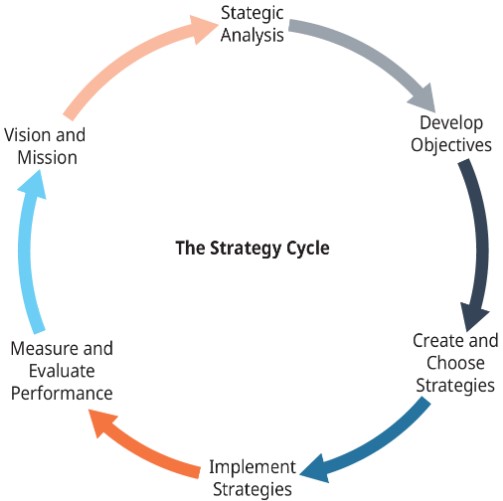Chapter 2. Strategy, Objectives, and Project Selection
2.1 Business Strategy and Goals
Organizations exist to fulfill a purpose. These purposes are analyzed through a process and ultimately expressed in an organization’s vision and mission statements. Vision statements are often very broad, describing what the organizational leaders want the organization to accomplish. Mission statements are more specific: they describe how the organization will fulfill its vision. Recently, on many organizations’ websites, mission and vision statements have not been explained separately, but as one statement named “mission statement”. Organizations may also elaborate on their principles, values, culture, and goals to explicate their missions. Some examples of vision and mission statements as well as other information such as principles, values, and culture are provided below:
LinkedIn[1]:
Vision: Create economic opportunity for every member of the global workforce.
Mission: The mission of LinkedIn is simple: connect the world’s professionals to make them more productive and successful.
Facebook[2]:
Mission: Give people the power to build community and bring the world closer together.
Culture: At Facebook, we are constantly iterating, solving problems, and working together to connect people all over the world. That’s why it’s important that our workforce reflects the diversity of the people we serve. Hiring people with different backgrounds and points of view helps us make better decisions, build better products and create better experiences for everyone.
Ikea[3]:
Vision: Our vision is to create a better everyday life for the many people – for customers, but also for our co-workers and the people who work at our suppliers.
Business idea: While our vision tells us why we exist, our business idea tells us what we want to achieve. And for everyone that has visited IKEA, our business idea is pretty obvious – “to offer a wide range of well-designed, functional home furnishing products at prices so low, that as many people as possible will be able to afford them.”
Microsoft[4]:
Mission: Our mission is to empower every person and every organization on the planet to achieve more.
One way to consider the interrelated nature of Vision and Mission Statements and other core components of an organization is to consider them part of a Strategy Cycle. Figure 2.1.1 presents an orderly process for strategic management that helps us understand the process and the components of strategic analysis. The cycle ends with “vision and mission” statements, which convey the executive summary of the whole process. We should also keep in mind that top managers usually deal with these steps simultaneously rather than following a stepwise approach.
Organizations create specific strategies that should be pursued in the long term. Projects are often used to help carry out those strategies. These long-term objectives help organizations gain a competitive advantage and a higher market share and eventually acquire various tangible and intangible benefits in line with organizations’ fields of operations (e.g., businesses, government agencies, nonprofits). These strategies are directly linked to the objectives being pursued and will vary widely depending on the industry and maturity of the organization. Whereas nonprofits or government agencies pursue to offer public and social benefits, companies would target to acquire financial benefits. Examples of strategies an organization may implement include launching new products and services, introducing new technology, streamlining operational processes, and employee development initiatives. The strategies are embodied in objectives, which are described in detail. The following section, “SMART objectives,” discusses how these objectives can be created in a way that makes sense to the organization and all the stakeholders
After identifying strategic objectives, organizations choose strategies that will guide them for a period of time (i.e., one year, three, five, or ten years) and move into the strategy implementation stage. Depending on the complexity of the changes being introduced, the strategies may be implemented as individual stand-alone projects or programs consisting of multiple related projects. Project and program managers apply their expertise to the implementation domain and play a vital role in helping organizations achieve their vision and mission. It is critically important that project and program managers understand an organization’s strategies and objectives. This knowledge allows them to ensure that the decisions being made in their projects and programs are aligned with the organization’s strategic direction.


